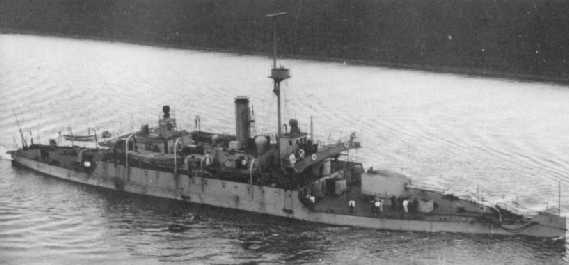Vickers manufactured these guns for the Brazilian river monitors Javary, Solimões and Madeira which were being built at Barrow. When it came time for delivery in 1914, the deal fell through as the Brazilians could no longer afford to pay for them. The ships were then laid up at the Devonshire Dock at Barrow until just prior to the start of World War I. At that time, First Sea Lord Winston Churchill expressed concern that these ships could be bought by an unfriendly power. As a result, the Royal Navy quickly purchased them in August 1914, renaming them Humber, Mersey and Severn.
These guns were generally identical, but were designed for use in twin turrets, with the Mark IV being the right-hand gun and the Mark XV being the left-hand gun.
As there were no spares, when these guns on Severn and Mersey wore out in October 1914 after extensive use off the Belgian coast, the turrets were removed and replaced with two single 6" (15.2 cm) BL Mark VII. Two of these guns had been salvaged from the pre-dreadnought HMS Montagu, which had been wrecked on Lundy Island in 1906. As Humber's guns were not so badly worn, she kept her turret.
During a bombardment of the Turkish village of Biyuk Anafarta on 9 June 1915, Humber suffered a bore premature in her right gun after 15 rounds. She remained in action with her other armament for a few more months until she was sent to Alexandria where both 6" (15.2 cm) guns were replaced by relined ones originally used on the other monitors.
Construction was similar to other Vickers wire guns of that time with cannelured rings at the forward inner A/A tube shoulders. Used a hand-worked Welin breech-block. A total of four guns of each Mark were built. The two spare guns, which for some reason were never used, differed in having tapered inner A tubes.
| Designation | 6"/50 (15.2 cm) BL Mark XIV and XV |
|---|---|
| Ship Class Used On | Severn class Monitors |
| Date Of Design | 1912 |
| Date In Service | 1914 |
| Gun Weight | 8.094 tons (8.2 mt) |
| Gun Length oa | 309.728 in (7.867 m) |
| Bore Length | 300.0 in (7.620 m) |
| Rifling Length | 265.2 in (6.736 m) |
| Grooves | N/A |
| Lands | N/A |
| Twist | N/A |
| Chamber Volume | 1,650 in3 (27.04 dm3) |
| Rate Of Fire | 6 rounds per minute 1 |
- ^
The Rate of Fire figure given above is from "Big Gun Monitors," but "Warrior to Dreadnought: Warship Development 1860-1905" quotes Jellicoe's 1906 figures for rates of fire for guns of this caliber in gunlayers' tests and in battle practice and notes that the latter figures corresponded well to those actually attained by the Japanese at Tsushima:
Gunlayers Test 12 rounds per minute Battle Practice 4 rounds per minute
| Type | Bag |
|---|---|
| Projectile Types and Weights 1a | CPC 4crh: 100 lbs. (45.3 kg) HE 4crh: 100 lbs. (45.3 kg) |
| Bursting Charge | CPC: 7.5 lbs. (3.4 kg) HE: 13.3 lbs. (6.0 kg) |
| Projectile Length | CPC: 23.5 in (59.7 cm) HE: 22.9 in (58.2 cm) |
| Propellant Charge | 28.63 lbs. (13.0 kg) MD26 |
| Muzzle Velocity | 2,900 fps (884 mps) |
| Working Pressure | N/A |
| Approximate Barrel Life | about 1,000 rounds |
| Ammunition stowage per gun | 150 rounds 2a |
| Designation |
|
|---|---|
| Weight | 100 tons (102 mt) |
| Elevation | -5 / +15 degrees |
| Elevation Rate | Manual operation, only |
| Train | about -150 / +150 degrees |
| Train Rate | Manual operation, only |
| Gun recoil | N/A |
These mountings were an improved version of the twin turret used in the Monmouth class cruisers. No mark number was ever assigned.
Data from:
- "Warrior to Dreadnought: Warship Development 1860-1905" by D.K. Brown
- "Big Gun Monitors: The History of the Design, Construction and Operation of the Royal Navy's Monitors" by Ian Buxton
- "British Naval Guns 1880-1945 No 12" article by John Campbell in "Warship Volume VIII"
- 07 January 2007
- Benchmark
- 20 February 2009
- Added details about bore premature

